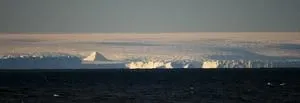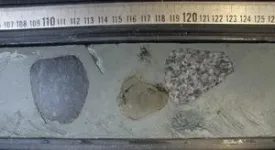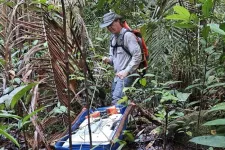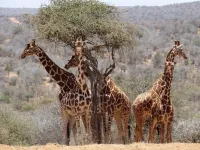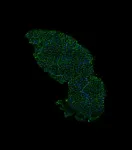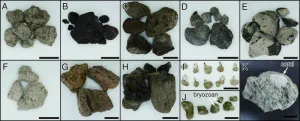(Press-News.org) It is no strange sight to see icebergs break off of the Antarctic ice cap and drift away, like the gigantic sheet of ice that is currently heading for the island of South Georgia. But climate change is making it happen more frequently, with ever-larger icebergs in the waters around Antarctica. Researchers from Utrecht University are studying the routes that icebergs followed during geological periods of rapid ice cap deterioration, such as the ends of ice ages. That provides crucial information about the effect of melting icebergs on the oceans, and its consequences for the future. In the process, they also found an explanation for the mysterious discovery of ancient material from Antarctica near South Orkney, an island to the southwest of South Georgia.
Ice caps grow as snow falls on the top and gravity pulls them slowly towards the sea. There, they lose large volumes of ice via melting and calving of icebergs. If the ice cap growth keeps pace with loss at the edges, then it remains in balance and stays the same size. But as the air and ocean around the south pole have warmed over the past few decades, icebergs calve off faster and more often: the meltwater on top weakens the ice, and the warmer ocean makes the ice shelves thinner. As a result, enormous ice blocks can break off from the shelves in a short amount of time.
Puzzle
The seas around South Georgia have a long history of iceberg research. The island is in the middle of waters that researchers call ‘Iceberg Alley’: a narrow strip of ocean full of icebergs that have calved off from the Antarctic ice cap, then pushed north by wind and ocean currents until they reach warmer seas and melt away entirely. Since Antarctica has had a large ice cap for around 34 million years, the remote islands around Iceberg Alley have seen countless icebergs pass by. South Orkney is one of these islands, and scientists have found that it preserves evidence of icebergs from as long as 3 million years before the ice cap was formed 34 million years ago. The discovery had long puzzled researchers. In 2017 they found around the island of South Orkney fragments of debris that originated in Antarctica. The only way for the Antarctic debris to travel all the way to South Orkney is via icebergs: the icebergs carry large amounts of stone fragments that glaciers had broken off of the Antarctic continent. When the iceberg melts, the debris sinks to the ocean floor.
The scientists were not surprised to find Antarctic debris near South Orkney, considering its location in Iceberg Alley. But they were astonished at the age of the sediments: 37 million years, 3 million years older than Antarctica’s large ice cap. Could Antarctica have already had an ice cap in the warm period of the late Eocene? And how could these icebergs survive in the warm ocean conditions prevalent around Antarctica at that time?
Cold enough
Utrecht University student Mark Elbertsen offered an answer to these questions in a recently published Master’s thesis project. Under the supervision of Peter Bijl from the Department of Earth Sciences and Erik van Sebille from the Institute for Marine and Atmospheric Research, he seized this geological puzzle by the horns. Using computer models, Mark calculated the origins of the icebergs that reached South Orkney during the late Eocene, and how large the icebergs must have been to survive the journey. He found that the Weddell Sea was cold enough at the time to transport medium-sized icebergs all the way to South Orkney. But that’s not all: the most logical starting point for the icebergs is also home to bedrock that corresponds to the types of rock found in the debris at South Orkney. Apparently, during the late Eocene Antarctica had an ice cap that was large enough to reach the coastline, and it moved fast enough to produce enough large icebergs that could survive the warm Weddell Sea and reach South Orkney. The study thus demonstrated that sufficient snow fell on Antarctica in the late Eocene to facilitate the required growth of ice caps and icebergs, 3 million years prior to the large freeze-over of Antarctica.
Fresh water
Bijl and van Sebille are once again joining forces in research. Recent geological history has known repeated phases of high rates of iceberg calving during rapid transitions from ice ages to interglacial periods. The EMBRACER climate research programme offers a job position for a PhD student to investigate these so-called ‘deglaciation’ phases. By following icebergs in computer simulations, the new study will identify how much meltwater the icebergs lost in the Southern Ocean during the melting phases, and how that changed conditions in the ocean.
Scientists would also like to better understand the consequences of the large volumes of meltwater that will reach the Southern Ocean in the near future. More fresh water in the Southern Ocean could affect the deep ocean currents and the ocean’s ability to absorb carbon. If climate change continues at its current pace, the Southern Ocean will soon face more and larger icebergs than in the past. The new study will use geologic reconstructions to provide more clarity about the potential consequences for the region.
Adrift
In 1986, iceberg A23a broke off of the Filchner ice sheet deep in the Weddell Sea. This super-iceberg remained stuck on the bottom of the shallow Weddell Sea for decades, until it began to drift away in 2020. It rode the waves for several years, until it recently set a course for the southern coast of South Georgia. Scientists are closely monitoring the iceberg’s progress, because South Georgia is an important breeding ground for colonies of penguins, seals and albatrosses. If iceberg A23a were to collide with the island, it would block countless animals’ access to breeding grounds and foraging waters. That is unlikely to happen, however, because the island is surrounded by a broad strip of shallow waters, against which A23a would most likely run aground. If that happens, the iceberg’s presence may even have a positive effect on the colonies, as there would be more food to find in the currents moving around the iceberg. The ocean’s currents may also guide the iceberg around the island, where it will gradually melt away in the open ocean.
END
Mega-iceberg from Antarctica on collision course with South Georgia: harbinger of things to come?
2025-02-24
ELSE PRESS RELEASES FROM THIS DATE:
Beneath the bog: FAU awarded $1.3 million to track carbon and gas flow in peatlands
2025-02-24
Peatlands, a type of wetland found around the globe at all latitudes – from the Arctic to the tropics – are important ecosystems that store vast amounts of carbon. In fact, peatlands hold about one-third of the world’s soil carbon, despite covering only about 3% of the Earth’s land surface. When peatlands are disturbed or altered, they can release that carbon back into the atmosphere as greenhouse gases like methane. Peatlands are valuable ecosystems both for their biodiversity and for their role in regulating climate.
Researchers ...
ETRI to collaborate on semiconductor technology with US Argonne National Laboratory
2025-02-24
Korean researchers will begin collaborating in earnest with the U.S. Department of Energy’s (DOE) Argonne National Laboratory (ANL) on semiconductor technology research.
Electronics and Telecommunications Research Institute (ETRI) announced on Jan. 6 (local time) that it has agreed to establish a mutual cooperation system to develop semiconductor technologies with Argonne National Laboratory in Illinois, USA.
ETRI has possessed the technology to develop and manufacture silicon detectors for high-energy particle detectors since the early 2000s ...
Unexpected discoveries in study of giraffe gut flora
2025-02-24
The gut bacteria of giraffes are not primarily determined by what they eat, but by the species they belong to. This is shown in a new study from Uppsala University and Brown University in which researchers have analysed the link between diet and gut flora in three giraffe species in Kenya. The study also provides new knowledge that can help secure the food supply of endangered giraffe species.
In a new study published in Global Ecology and Conservation, researchers have analysed the relationship between the diet and microbiome, or gut flora, of giraffes in Kenya. By sequencing plant and bacterial DNA from faecal samples, they were able to investigate both the bacterial composition ...
Not all heart inflammation is the same
2025-02-24
A group of Berlin researchers in collaboration with international scientists have found differences in heart inflammation caused by COVID-19, anti-COVID-19 vaccination, and non-COVID-19 myocarditis. The find paves the way for more personalized therapies, they report in “Nature Cardiovascular Research.”
Heart inflammation, or myocarditis, differs depending on its cause. A collaborative study led by Dr. Henrike Maatz, a scientist in the Genetics and Genomics of Cardiovascular Diseases lab of Professor Norbert Hübner at the Max Delbrück ...
New home-based intervention could reduce emergency hospital admissions for older people
2025-02-24
A new service aimed at supporting older people who are starting to become frail, could reduce emergency hospital admissions by more than a third and save the NHS money, finds a new study led by UCL researchers.
The results from the clinical trial, published in The Lancet Healthy Longevity and funded by the National Institute for Health and Care Research (NIHR), evaluated the effect and cost-effectiveness of a new service, consisting of six personalised home-based visits from a support worker, tailored to each person to identify what they need to stay well and independent.
Interventions ...
Can exercise help colon cancer survivors live as long as matched individuals in the general population?
2025-02-24
Physical activity may help colon cancer survivors achieve long-term survival rates similar to those of people in the general population, according to a recent study published by Wiley online in CANCER, a peer-reviewed journal of the American Cancer Society.
Individuals with colon cancer face higher rates of premature mortality than people in the general population with matched characteristics such as age and sex. To assess whether exercise might reduce this disparity, investigators analyzed data from two posttreatment trials in patients with stage 3 colon cancer, with a total of 2,875 patients who self-reported ...
Unlicensed retailers provide youths with easy access to cannabis in New York City
2025-02-24
NEW YORK, NY (Feb. 24, 2025)--A new study, led by researchers at Columbia University, suggests it is easy for youths to purchase cannabis from unlicensed dispensaries in New York City, despite state laws that bar access to recreational cannabis to those under age 21.
“Regulation to restrict access in this age group is based on evidence that cannabis affects working memory, brain development, and increases addiction risk when used at an early age,” says Ryan Sultán , an assistant professor ...
Scientists track evolution of pumice rafts after 2021 underwater eruption in Japan
2025-02-22
Tokyo, Japan – Researchers from Tokyo Metropolitan University have carried out an unprecedentedly detailed survey of pumice rafts in the aftermath of the 2021 Fukutoku-Oka-no-Ba volcanic eruption in Japan. Using samples from 213 different locations, they considered raft density, the size and roundness of individual pumice, and biological species attached. Their findings revealed three phases in the evolution of drift pumice, involving rounding, fragmentation, and the diversification of attached biological organisms over time.
It is said that 85% of volcanic eruptions happen underwater. While their cousins on land might seem more vivid, the effects of underwater eruptions can be just as ...
The future of geothermal for reliable clean energy
2025-02-21
Historically, access to geothermal energy has hinged on real estate’s famously three most important factors: location, location, and location. Because conventional geothermal power plants require hot, permeable rocks and plenty of underground fluid, use of the technology has been limited mostly to places with recent volcanism, such as Japan, New Zealand, the Philippines, Kenya, El Salvador, Iceland, and the western United States.
Over the past 50 years, however, techniques originally developed for oilfields and adapted for “enhanced geothermal systems” (EGS) have offered the promise ...
Study shows end-of-life cancer care lacking for Medicare patients
2025-02-21
Many Medicare patients with advanced cancer receive potentially aggressive treatment at the expense of supportive care, according to a study that analyzed Medicare records.
The study, published in JAMA Health Forum, examined the quality of end-of-life care among 33,744 Medicare decedents. The study involved patients of diverse ethnic backgrounds, age 66 or older who died from breast, prostate, pancreatic or lung cancers.
Overall, claims records showed that 45% of the patients experienced potentially ...

